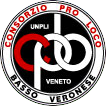GEOGRAPHY
The town, with its surface of 13.51 km², is located at an average altitude of 19 m above sea level. It is around 40 km south-east from Verona, and its territory is completely flat, typical of the Po Valley. Sanguinetto borders with the comuni di Casaleone, Cerea, Concamarise, Gazzo Veronese, Nogara and Salizzole.
ETYMOLOGY
The town’s name’s origins are quite uncertain. It may come from the several bloody battles for the conquest of its lands that took place over the centuries, or it could be referring, as someone claims, to a plant called Cornus Sanguinea, commonly called Sanguinello, which is indeed a deciduous shrub that produces red berries. The only certain thing remains the old age of this name, which is already recorded in 930, as pointed out by scholars and researchers.
HISTORY
The findings of former Roman settlements in the town’s surroundings lead to the conclusion that the name Sanguinetto comes from the Latin word sanguinis, referencing the several battles that took place in these lands. According to a different interpretation, the town’s name originates in the term sanguina, a plant with red berries, once very widespread in the lower Veronese valley. Altough fortified and guarded by a castle, the town was ravaged by Mantova’s troops in 1232, in a time when the Po Valley was theatre of wars between cities and was crossed by the Christian movement of Alleluia.
Later the castle passed under the administration of the Dalla Scala, and awarded as fief to mercenary captain Jacopo dal Verme. In 1377 the property was sold to another mercenary leader called Gentile della Leonessa, who split it between his three daughters, who were respectively married to: a Lion of Padova, a Venier of Venezia and a Martinengo of Brescia, lawful owners of the land up until the 1700s.
In 1751, to testify in a trial, the author Carlo Goldoni resides in Sanguinetto. Napoleon Bonaparte will fight in the town’s land, risking his very life against the Austrian Army. He visited Sanguinetto on the days before his coronation.
On 15 September 1810, the poets Ippolito Pindemonte, Alessandro Verri and Perticari, spent the night at the hotel of the “Posta”. Worth of note are the bloody battles of the Risorgimento between Austrians, and the French, Spanish and Piemontese Army. Even Garibaldi was a guest in palazzo Betti in 1859, just like Franceso Giuseppe in 1848. In Sanguinetto is awarded the national prize Gaetano Zinetti addressed to the young musicians about to enter the footlights of the music world, and the national prize of juvenile literature Premio Castello.
ART
The massive castle in the heart of the town is a must see. Its bulk recalls memories of historical events in which the fortification has played a central role since the Middle Ages. Built on the orders of the Scaligeri, it was then granted to lieutenant Dal Verme, who left it to his son Alvise and then to pass from heir to heir until today. Currently it is part of the compound is of municipal property, except for the south-western tower, still private. Not too far from the Castle, there is the seventeenth-century convent of Santa Maria delle Grazie, closed down in 1769 according to a law of the Venetian Senate, that was trying to limit the power of the clerical orders on its lands. The convent was completely restored in the years 2007-2008 with the addition of Museum and civic halls. Entering the town, there is the eighteenth-century Church della Rotonda. Built in 1747, designed by architect Alessandro Pompei and entitled to the Beata Vergine, but known as “Chiesa della Rotonda” or “Oratorio delle Tre Vie”. Another place worth visiting is the parish of San Giorgio Martire, built on the remains of a former chapel, completed in 1835 according to the project of Giovanni Cannella from Verona. It received the blessing in 1826 and was consecrated on 03 May 1835. The painter Gaetano Miolato, between 1925 and 1929, frescoed the interiors with 14 pieces of the Via Crucis, the “last dinner” and “the multiplication of Loaves” on the sides of the main altar in addition to the martyrdom of San Giorgio” (patron saint of the town) in the apse. The “Resurrection of Christ” is a painting by Agostino Pegrassi, and so are the pictures on the windows.
Beautiful and elegant palaces are built on the main street, such as Palazzo Lombardi, Palazzo Betti and Palazzo Taidelli all of 18th-century, and Palazzo La Rangona of 16th-century.
ECONOMY
Craftmanship and industrial production prevail on agriculture and animal farming. The industry of stylish furniture, established on a network of family businesses, grants a strong competitiveness on foreign markets, and consequentely leads to the opening of highly specialized shops in the restoration business. Also active is the packaging branch and the food processing industry. Typical food of Sanguinetto are “I rofioi” an excellent sweet to which a whole festivity is dedicated.
